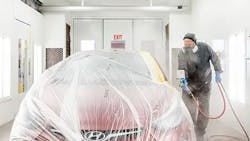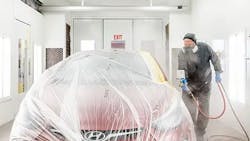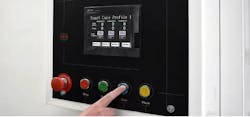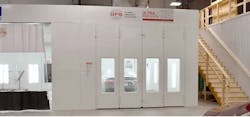For collision repair centers with significant volume, having a heated paint booth is essential to avoid backlogs and keep up with production demands. Heated paint booths have key modes that make operating the spray booth a breeze and ensure efficient, quality paint finishes. Let’s break down each mode:
1. Spray mode
The first mode that is used when operating a paint booth is spray mode, during which paint is sprayed onto the vehicle. Spray mode ensures the paint booth has the correct air pressure and temperature to produce your desired results.
To activate spray mode in a GFS paint booth, the operator turns on the power to the paint booth, then presses the "Spray" button on the control panel. The spray cycle runs as follows:
- The damper automatically positions itself, allowing the intake blower assembly to draw in fresh outside air.
- The intake air passes through the pre-filter, then through the burner or around the heat exchanger.
- The outside air is heated to the desired spray temperature, as defined by the booth controls.
- The spray gun becomes active.
- The air passes through the intake filters, enters the paint booth, and is evenly distributed throughout the cabin of the booth.
- The air is exhausted through the paint arrestor filters, where most of the overspray is removed.
- The air enters the exhaust chamber and travels through the exhaust duct to the outside.
2. Flash mode
Flash mode is initiated on the control panel or by using an optional puff switch inside the booth. During flash, the booth temperature increases, allowing solvents to be rapidly released from the paint before the next coat or the final cure.
The temperature and duration of flash mode depends on the type of paint and application method used. The time setting is determined by the painter, often based on the recommendation of the paint company’s safety data sheet (SDS).
Depending on the spray booth configuration, the transition to flash mode may include a purge cycle to evacuate contaminated air from the paint booth. If the paint booth has a GFS AdvanceCure System, it comes on at this time. If the burner is selected on, you can use an elevated flash temperature.
3. Cure mode
Cure mode enables the curing of the paint that was sprayed onto the vehicle. During the cure cycle, the paint booth will reach and hold a preset temperature — up to 200 degrees F. For operator safety, no one should enter the booth during cure mode.
The operator starts the cure cycle at the control panel. This activates a preset timer. The cure time counter starts when the paint booth reaches the preset temperature.
The cure mode operating cycle on a GFS paint booth is as follows:
- The damper automatically positions itself to permit the intake blower assembly to draw a portion of the air from the outside (10 to 15 percent) and recirculate the remaining air (85 to 90 percent).
- All of the air passes through the pre-filter, then through the burner or around the heat exchanger.
- The outside air is heated to the desired cure temperature, as defined by the booth controls.
- The air passes through the intake filters, enters the paint booth, and is evenly distributed throughout the cabin of the booth.
- The air is exhausted through the paint arrestor filters, then enters the exhaust chamber, where 10 to 15 percent of the air is expelled outside, and the remaining 85 to 90 percent is recirculated.
4. Cool down
The cooling phase is the time required to cool down the heating unit, and the interior of the paint booth following cure mode. This phase starts automatically upon completion of the cure period.
If the temperature setting is too low, it becomes impossible for the outside air to cool the paint booth to the preset temperature. In this case, a preset timer interrupts the cooling, even if the preset temperature has not been reached.
Cool down is similar to spray mode in that the dampers automatically position themselves to draw 100 percent fresh air from the outside.
Power to the paint booth should never be turned off during cool down. Doing so will stop the blower assembly, preventing the proper cooling of the combustion chamber, which could overheat and become damaged.
Knowing how each of the four modes in a heated paint booth functions can help body shops maximize efficiency and promote quality paint finishes while keeping up with production demands.





